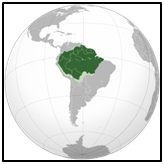Why in News?
- The Amazon rainforest is reeling from an intense drought. Numerous rivers vital for travel have dried up.
- As a result, there is no water, food, or medicine in villages of indigenous communities living in the area.
What’s in Today’s Article?
- About Amazon Rainforests
- Drought in Amazon Rainforests (Context, Causes, Impact, Future, etc.)
About Amazon Rainforests:

- The Amazon rainforest, also called Amazon jungle or Amazonia, is a moist broadleaf tropical rainforest in the Amazon biome that covers most of the Amazon basin of South America.
- This basin encompasses 70 lakh km2 of which 55 lakh km2 are covered by the rainforest.
- This region includes territory belonging to nine countries and more than 3300 formally acknowledged indigenous territories.
- The majority of the forest, 60%, is in Brazil, followed by Peru with 13%, Colombia with 10%.
Drought in Amazon Rainforests:
- Eight Brazilian states recorded the lowest rainfall between July 2023 to September 2023 in over 40 years.
- Rainfall is forecast to be below average until the end of the year.
- The latest calamity is becoming another cause for accelerating the destruction of the Amazon, called the planet's lungs (storing more than 150 billion metric tonnes of carbon).
Impact of the Drought:
- Drying of Water Bodies:
- The Rio Negro, one of the world’s largest rivers by discharge levels, has fallen to a record low level of 13.59 metres.
- The drought has also affected the Madeira River, another vital Amazon tributary, causing Brazil's fourth largest hydroelectric dam, Santo Antonio, to halt its operations due to historically low water levels.
- Death of Marine Species:
- High numbers of fish and river dolphins, known as Boto, have been washing up dead due to low water levels.
- Also, their rotting carcasses have contaminated the water supply in some areas, forcing residents to use it for cooking, bathing, and drinking.
- State of Emergency:
- Brazilian authorities fear that about 500,000 people may be affected due to the drought by the end of October.
- Manaus, the largest city and capital of Amazonas, the state hit hardest by the drought, declared states of emergency in 55 out of 62 municipalities due to the severe water shortage.
- Increase in Wildfires:
- The extreme dry conditions have made the rainforest more vulnerable to wildfires too.
- So far this month, the Amazonas state has witnessed 2,700 blazes — the highest ever noted for the month of October since the records began 25 years ago.
- Smoke from wildfires has plummeted air quality in Manaus, a city of two million in the middle of the Amazon, to hazardous levels.
Causes Behind the Drought:
- Droughts aren’t unheard of in the Amazon. Most recently, the rainforest witnessed a dry spell in 2021, which was the worst in at least 90 years.
- The latest drought, however, is probably even more severe as two simultaneous natural events have hindered cloud formation, further reducing the already low rainfall levels in the region.
- Role of El Nino:
- El Nino refers to an abnormal warming of surface waters in the equatorial Pacific Ocean.
- The weather pattern is known to increase the likelihood of breaking temperature records and triggers more extreme heat in many parts of the world and in the ocean.
- High Water Temperatures in Atlantic Ocean:
- The other weather event is the unusually high water temperatures in the northern tropical Atlantic Ocean.
- Due to warmer ocean waters, heated air rises into the atmosphere, which then reaches the Amazon rainforest.
- The warm air inhibits the formation of clouds, causing rainfall to drop sharply.
Concerning Studies on the Future of the Amazon Rainforests:
- Over the years, several studies have indicated that with rising global temperatures, the Amazon will experience longer and more frequent droughts.
- A 2022 study, published in the journal Proceedings of the National Academy of Sciences (PNAS), said “if humans continue burning fossil fuels at the current rate, the rainforest would experience major drought 9 out of every 10 years by the year 2060”.
- Another study, published in the journal Nature in 2022, revealed that the Amazon has become slower at recovering from longer periods of drought over the past 20 years and is nearing its tipping point.
- Beyond the tipping point, it would transform from a lush green forest into a drier open savanna, releasing a large amount of stored carbon, which would, in turn, exacerbate global warming.
- In the past five decades, between 17 and 20 per cent of the Amazon has been destroyed.
- Therefore, there is an urgent need to curb deforestation and greenhouse gas emissions to protect the Amazon, and, where possible, reforest the degraded swathes according to experts.









